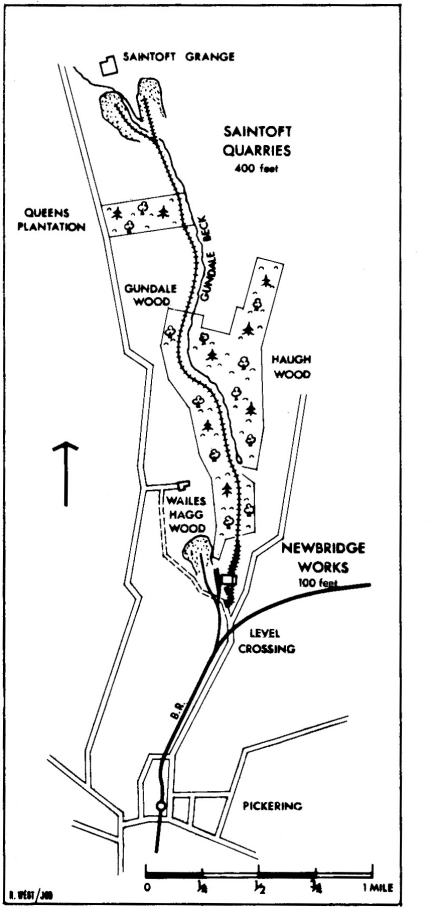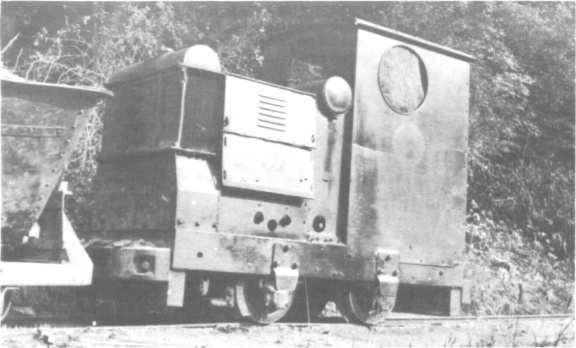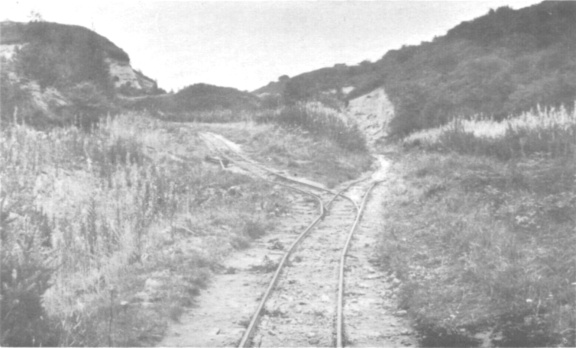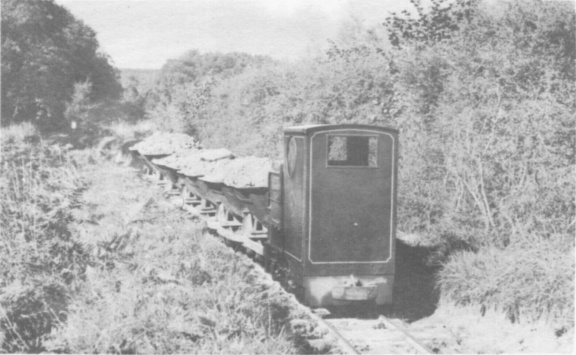|
THE INDUSTRIAL RAILWAY RECORD |
No. 11 |
© SEPTEMBER 1966 |
SANDSTONE FROM SAINTOFT
ALAN THORNTON JONES
 Until October 1961, General Refractories Ltd. operated a two
foot gauge tramway system at their Newbridge Works, near Pickering in North
Yorkshire. Originally built in 1919 by the Pickering Sand Co. Ltd., the tramway
ran for a distance of 2½ miles and served sand quarries (now abandoned) at the
northern edge of Gundale Wood, and at Saintoft. Two quarries at Saintoft (one
now disused) were served by separate branches from a junction just north of
Queens Plantation, though it is doubtful whether both quarries were worked
simultaneously. The Gundale workings on the other hand were less extensive since
only that sandstone which lay in the immediate path of the tramway was removed.
Until October 1961, General Refractories Ltd. operated a two
foot gauge tramway system at their Newbridge Works, near Pickering in North
Yorkshire. Originally built in 1919 by the Pickering Sand Co. Ltd., the tramway
ran for a distance of 2½ miles and served sand quarries (now abandoned) at the
northern edge of Gundale Wood, and at Saintoft. Two quarries at Saintoft (one
now disused) were served by separate branches from a junction just north of
Queens Plantation, though it is doubtful whether both quarries were worked
simultaneously. The Gundale workings on the other hand were less extensive since
only that sandstone which lay in the immediate path of the tramway was removed.
At first most of the sandstone was sold uncrushed, but
towards the middle of the nineteen-twenties the Company decided to use some of
the mineral for manufacturing bricks and a works was erected at Newbridge. In
its early days the output of bricks was fairly constant, but a gradual decline
towards the years of the depression showed that such a project had not been
profitable. One assumption which holds some justification is that sand bricks,
being somewhat soft and prone to early weathering, were recognised by
prospective purchasers to be a poor investment and, because there were many
rival brick manufacturers in the area who produced better bricks (with a clay
content), the Pickering Sand Co. Ltd. was to a considerable extent affected and
by 1932 production had ceased. The brickmaking part of the works was dismantled,
except for the tipping dock and crushing plant which are still in use today.
Locomotives have been used on the tramway ever since
quarrying began, and the first example is thought to have been built up by a
local firm of general and agricultural engineers, the North and East Riding
Engineering Co. Ltd. It is said to have been extremely primitive in
construction, having a complete lack of weather protection, and was powered by a
single cylinder Alpha petrol engine which caused excessive vibration at all
speeds, resulting in a very uncomfortable ride. Nevertheless it proved quite
successful, a fact which no doubt satisfied the company even if not the
unfortunate driver, since it was retained for over fifteen years.
By 1928 it had become apparent that a single locomotive was
not sufficient to cope with the ever increasing output of sandstone, and
therefore a second locomotive, this time steam powered, and named FORWARD, was
purchased. This locomotive, built in 1919 by Kerr, Stuart & Co. Ltd., was
originally one of a batch of twelve 2ft 0in gauge ‘Wren’ type 0−4−0 saddletanks
with 6in by 9in cylinders and 1ft 8in wheels (see RECORD 5/6), ordered by the
Ministry of Munitions in August 1918. As works number 4016, she was despatched
new from Stoke on 4th February 1919 to the Scottish Aircraft Repair Depot at
Renfrew at a cost of £795. (There is some doubt as from where FORWARD was
obtained; one version gives "Air Ministry, London". However, Kerr Stuart records
show that at some period 4016 was at "Ilford", but whether with the Air Ministry
or possibly the Ilford Gas Company - where sister engine 4020 worked - is not
known. Also, the name FORWARD suggests perhaps, an association with Thos. W.
Ward Ltd. - Hon. Eds.) Under Pickering Sand ownership FORWARD enjoyed regular
use but because of her poor condition was not retained for long. In the 1932
trade depression, when General Refractories Ltd. gained overall control of
Newbridge Works, she was withdrawn from service and, after lying outside
derelict for several months, scrapped onsite; the metal was sold to H. Dale of
Kirkbymoorside although he did not do the actual scrapping.

Ruston 175410 at
Newbridge on 6th
September 1961.
(A. T.
Jones)

The junction near Saintoft in September 1961. The section to
the right
was latterly disused. (R. A. Hodge)

Ruston 170373 emerges from the shadows of Wailes Hagg Wood on
30th August
1961 with a load of sandstone from Saintoft. (A. T. Jones)
In 1936 a small 18/21 h.p. 4−wheel diesel locomotive, works
number 175410, was purchased new from Ruston & Hornsby Ltd., Lincoln, and was
followed three years later by a similar but smaller machine, works number
193975. During or immediately after the Second World War, however, the latter
was sold to the Billing Gravel Co. Ltd. in Northamptonshire and replaced by a
further Ruston diesel, this time of 16/20 h.p., built in 1934 and works number
170373. It was purchased second-hand from Hargreaves & Jones Ltd. of Chelford in
Cheshire, and arrived at Newbridge without a cab although one was subsequently
fitted. At the turn of the half century a fourth and final Ruston diesel
locomotive was acquired from an associated company, the Meltham Silica Firebrick
Co. Ltd., near Huddersfield. Built in 1936 as works number 175988, this
locomotive was larger than the previous three, having three cylinders instead of
two and a horsepower rating of 27/32.
Normally, between eighty and a hundred tons of sandstone were
conveyed down the tramway daily, necessitating two locomotives in regular use.
As there were no passing places on the tramway only one locomotive at a time was
able to complete a full journey - Saintoft to Newbridge (full), Newbridge to
Saintoft (empty) - during which time the second train was being filled up at the
quarry. Some seven tubs would arrive at Newbridge at roughly hourly intervals
throughout the day.
On 13th October 1961 when, after much uncertainty, locomotive
haulage finally ceased, quarrying was suspended until the tramway had been
lifted and a suitable roadway constructed over a similar route. One of the
locomotives was used to assist in the actual dismantling which was completed in
twelve days. Most of the track was brought down to Newbridge and stacked with
some sort of neatness outside the works but the many tubs, some of which had not
been used for several years, were dumped all around the immediate vicinity. On
29th October 1961 the scene could well have been described as one of gradual
metallic decay. The three locomotives awaiting disposal stood together on the
tipping dock and all rail access to them had been lifted.
A visit to Newbridge in October 1963 revealed that one of the
Rustons (170373) had departed a few months previously to the Firm’s Batts Works
at Wolsingham in County Durham; it was not, however, to be used as a locomotive.
Although everything else has remained the same it is unlikely to do so for much
longer as the scrap merchants are on their way to remove the final traces of
this interesting tramway.
* * * * * * * * * * * * * * * * * * * * * *
*
"BRISTOL. - A locomotive has been tried with success on the
tramway lines. The makers are Messrs. Fox, Walker and Co., who are supplying the
engine to a company at Rouen. On the Bristol tramways some of the gradients are
very steep, and the locomotive ascended them, drawing a loaded car, with
comparative ease."
("Iron, Friday, 8th December 1877.)
(K.P.P.)





 Until October 1961, General Refractories Ltd. operated a two
foot gauge tramway system at their Newbridge Works, near Pickering in North
Yorkshire. Originally built in 1919 by the Pickering Sand Co. Ltd., the tramway
ran for a distance of 2½ miles and served sand quarries (now abandoned) at the
northern edge of Gundale Wood, and at Saintoft. Two quarries at Saintoft (one
now disused) were served by separate branches from a junction just north of
Queens Plantation, though it is doubtful whether both quarries were worked
simultaneously. The Gundale workings on the other hand were less extensive since
only that sandstone which lay in the immediate path of the tramway was removed.
Until October 1961, General Refractories Ltd. operated a two
foot gauge tramway system at their Newbridge Works, near Pickering in North
Yorkshire. Originally built in 1919 by the Pickering Sand Co. Ltd., the tramway
ran for a distance of 2½ miles and served sand quarries (now abandoned) at the
northern edge of Gundale Wood, and at Saintoft. Two quarries at Saintoft (one
now disused) were served by separate branches from a junction just north of
Queens Plantation, though it is doubtful whether both quarries were worked
simultaneously. The Gundale workings on the other hand were less extensive since
only that sandstone which lay in the immediate path of the tramway was removed.

